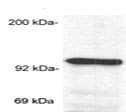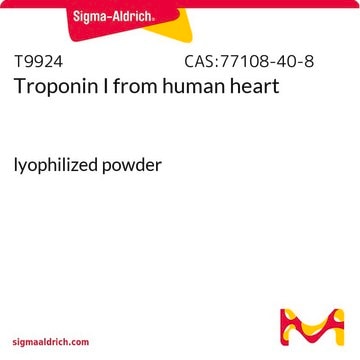추천 제품
생물학적 소스
mouse
Quality Level
항체 형태
purified antibody
항체 생산 유형
primary antibodies
클론
BuGR2, monoclonal
형태
lyophilized
포함
≤0.1% sodium azide as preservative
종 반응성
guinea pig, rabbit, rat, mouse, sheep
반응하면 안 됨
amphibian, primate, avian
제조업체/상표
Calbiochem®
저장 조건
OK to freeze
동형
IgG2a
배송 상태
ambient
저장 온도
−20°C
타겟 번역 후 변형
unmodified
유전자 정보
mouse ... Nr3C1(14815)
일반 설명
Anti-Glucocorticoid Receptor (Ab-2), mouse monoclonal, clone BuGR2, recognizes ~94-97 kDa glucocorticoid receptor in mouse liver. It is validated for WB, ICC, IP & IHC (Frozen & paraffin sections).
Purified mouse monoclonal antibody generated by immunizing BALB/c mice with the specified immunogen and fusing splenocytes with P3-AgX-653 myeloma cells (see application references). Recognizes the ~94-97 kDa glucocorticoid receptor.
Recognizes the ~94-97 kDa glucocorticoid receptor in mouse liver tissue.
면역원
Rat
partially purified, rat glucocorticoid receptor
애플리케이션

Frozen Sections (5 g/ml)
Immunoblotting (5 g/ml)
Immunocytochemistry (5 g/ml)
Immunoprecipitation (see comments)
Paraffin Sections (5 g/ml)
경고
Toxicity: Standard Handling (A)
물리적 형태
Lyophilized from PBS, pH 7.2.
재구성
Resuspend the lyophilized antibody with 0.1 ml sterile PBS, pH 7.2. Be careful to reconstitute the entire contents of the vial; during shipment and handling, portions of the lyophilized pellet may have become dislodged and may not be in the bottom of the vial. Following reconstitution, aliquot and freeze (-20°C). Avoid freeze/thaw cycles of solutions.
분석 메모
Positive Control
mouse liver extract
mouse liver extract
기타 정보
Does not cross react with androgen, progesterone, estrogen or mineralocorticoid receptors. Enzymatic digestion and immunoblot analysis has shown that this antibody reacts with the undigested 97 kDa glucocorticoid receptor, a 17 kDa DNA-binding trypsin fragment, and a 45 kDa steroid and DNA-binding chymotrypsin fragment. Immunocytochemical localization of the glucocorticoid receptor is observed in the cytoplasm and nucleus, even in the presence of hormone. This antibody has also been reported to work for immunoprecipitation. Antibody should be titrated for optimal results in individual systems.
Hussien, A., et al. 1997. Proc. Natl. Acad. Sci. USA94, 1521.
Pratt, W.B. and Toft, D.O., 1997. Endocrine Rev.18 306.
Schumacher, M., et al. 1996. Dev. Neurosci.18, 6.
Toran-Allerand, C.D. 1996. Dev. Neurosci.18, 36.
Weigel, N.L. 1996. Biochem J.319, 657.
Jones, K.J. 1994. Ann. N.Y. Acad. Sci.743, 141.
Arnold, A.P. 1990. in Hormones, Brain and Behavior in Vertebrates, ed. Balthazart, J. (Karger, Basel), 82.
Pratt, W.B. and Toft, D.O., 1997. Endocrine Rev.18 306.
Schumacher, M., et al. 1996. Dev. Neurosci.18, 6.
Toran-Allerand, C.D. 1996. Dev. Neurosci.18, 36.
Weigel, N.L. 1996. Biochem J.319, 657.
Jones, K.J. 1994. Ann. N.Y. Acad. Sci.743, 141.
Arnold, A.P. 1990. in Hormones, Brain and Behavior in Vertebrates, ed. Balthazart, J. (Karger, Basel), 82.
법적 정보
CALBIOCHEM is a registered trademark of Merck KGaA, Darmstadt, Germany
Not finding the right product?
Try our 제품 선택기 도구.
Storage Class Code
11 - Combustible Solids
WGK
WGK 1
Flash Point (°F)
Not applicable
Flash Point (°C)
Not applicable
시험 성적서(COA)
제품의 로트/배치 번호를 입력하여 시험 성적서(COA)을 검색하십시오. 로트 및 배치 번호는 제품 라벨에 있는 ‘로트’ 또는 ‘배치’라는 용어 뒤에서 찾을 수 있습니다.
Mohammad M Khan et al.
Neuroendocrinology, 84(5), 317-329 (2006-12-05)
MNAR/PELP1 (see text) is a newly identified scaffold protein/coactivator initially thought to modulate nongenomic and genomic actions of the estrogen receptor; however, it has been recently shown to interact with multiple steroid receptors, including androgen and glucocorticoid receptors. In the
FoxA1 specifies unique androgen and glucocorticoid receptor binding events in prostate cancer cells.
Biswajyoti Sahu et al.
Cancer research, 73(5), 1570-1580 (2012-12-28)
The forkhead protein FoxA1 has functions other than a pioneer factor, in that its depletion brings about a significant redistribution in the androgen receptor (AR) and glucocorticoid receptor (GR) cistromes. In this study, we found a novel function for FoxA1
Nina M Patrick et al.
The Journal of steroid biochemistry and molecular biology, 167, 1-13 (2016-09-21)
Small molecule inhibitors of lysine deacetylases (KDACs) are approved for clinical use in treatment of several diseases. Nuclear receptors, such as the glucocorticoid receptor (GR) use lysine acetyltransferases (KATs or HATs) and KDACs to regulate transcription through acetylation and deacetylation
Vineela Kadiyala et al.
The Journal of biological chemistry, 288(40), 28900-28912 (2013-08-16)
Nuclear receptors use lysine acetyltransferases and lysine deacetylases (KDACs) in regulating transcription through histone acetylation. Lysine acetyltransferases interact with steroid receptors upon binding of an agonist and are recruited to target genes. KDACs have been shown to interact with steroid
자사의 과학자팀은 생명 과학, 재료 과학, 화학 합성, 크로마토그래피, 분석 및 기타 많은 영역을 포함한 모든 과학 분야에 경험이 있습니다..
고객지원팀으로 연락바랍니다.








